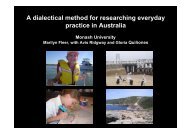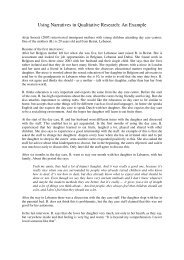2. Multilingual Toddlers in Swedish Pre-schools
2. Multilingual Toddlers in Swedish Pre-schools
2. Multilingual Toddlers in Swedish Pre-schools
Create successful ePaper yourself
Turn your PDF publications into a flip-book with our unique Google optimized e-Paper software.
<strong>Multil<strong>in</strong>gual</strong> <strong>Toddlers</strong> <strong>in</strong> <strong>Swedish</strong><strong>Pre</strong>-<strong>schools</strong>: What is the Role ofLanguage <strong>in</strong> Initiat<strong>in</strong>g andMa<strong>in</strong>ta<strong>in</strong><strong>in</strong>g <strong>Pre</strong>tend Play?EECERAPrague01.09.2007Anne Kultti,PhD candidateGöteborg UniversitySwedenAnne.Kultti@ped.gu.se
<strong>Pre</strong>school <strong>in</strong> Sweden Children 1 to 6 years old. 45 % of 1 year olds & 87 % of 2 yearolds (2004). 90 % public National Curriculum for <strong>Pre</strong>school wasimplemented <strong>in</strong> 1998. 15 hours/week free of charge (from ageof 4).
Young Children's Learn<strong>in</strong>g A <strong>Swedish</strong> longitud<strong>in</strong>al research project(2005-) Variation of learn<strong>in</strong>g environments <strong>in</strong>preschool – children’s knowledge and learn<strong>in</strong>gwith<strong>in</strong> four areas: language &communication, mathematics, creativity and<strong>in</strong>teraction. Includes 230 children (born <strong>in</strong> 2004/05) <strong>in</strong> 38pre<strong>schools</strong> <strong>in</strong> a larger city <strong>in</strong> Sweden.
My thesis <strong>in</strong> progress To study multil<strong>in</strong>gual toddlers languagelearn<strong>in</strong>g (<strong>Swedish</strong>) through social actions andactivities <strong>in</strong> the preschool context. 10 focus children at age of 2 <strong>in</strong> 8 differentsett<strong>in</strong>gs. Video-record<strong>in</strong>gs dur<strong>in</strong>g a period of sixmonths. Interaction with other children and teachers<strong>in</strong> a variety of everyday situations <strong>in</strong>preschool contexts. Children’s first languages; Nordic, European,and African.
Language is essential <strong>in</strong>learn<strong>in</strong>g When enter<strong>in</strong>g preschool- children take part <strong>in</strong> expanded social andlanguage/communication contexts.- children with <strong>Swedish</strong> as second languagemeet a new language. Second language learn<strong>in</strong>g (languageenvironment). Play especially is important for children whenlearn<strong>in</strong>g a new language(Aronsson,, Grover Aukrust, , 2004).
Theoretical frameworkSocio-cultural cultural perspective on learn<strong>in</strong>g anddevelopment (Vygotsky34/1986; Säljö 2000; Rogoff: : 2003).How tools (language and physical artifacts) ) are used<strong>in</strong> a specific practice, and how these tools affectpeople’s ways of talk<strong>in</strong>g and act<strong>in</strong>g (Säljö2000).‘Individual – social practice – artifacts’The child is seen as a competent and active actor <strong>in</strong><strong>in</strong>teraction, who both shapes and is shaped byparticipat<strong>in</strong>g <strong>in</strong> an activity.What does the situation offer for children to learn?
Mandisa, , Hanna & Daniella Mandisa; ; <strong>2.</strong>8 years. 3 languages (2African and English) are spoken at herhome. Hanna; 3.3. Arabic is her first language. Daniella; ; 3.<strong>2.</strong> <strong>Swedish</strong> is her firstlanguage.
Before and after... The teacher gives the girls the toys with<strong>in</strong> thetheme and creates room for the play. Hanna & Daniella start play<strong>in</strong>g with the toyswhile Mandisa is sitt<strong>in</strong>g next to themwatch<strong>in</strong>g. Hanna & Daniella tell Mandisa to lay down. The play goes on for a while after thissequence.
The play consists of both; The children’s knowledge about theplay theme. The children’s knowledge about how toplay.
The children’s knowledge about theplay theme Based on their personal experiences of– Be<strong>in</strong>g sick and stay<strong>in</strong>g at home– Go<strong>in</strong>g to see a doctor– How to use the toys with<strong>in</strong> the theme as aresource.– Roles: doctor & patient
Doctor & patientDOCTOR:H: Open your belly… your belly… there is the belly… like that… xxlike that..D: Lay like this. (She lifts her arm to demonstrate.) Medic<strong>in</strong>e…medic<strong>in</strong>e. . Lay like this now.Hanna takes a stethoscope and holds it on Mandisa’s stomach.Mandisa dr<strong>in</strong>ks out of a bowl.PATIENT:Mandisa looks at her but lies still on her back.Hanna lies down on the mattress and pulls up her sweater.Hanna ’grimaces’ when the syr<strong>in</strong>ges are pulled to her stomach.
<strong>Pre</strong>tend<strong>in</strong>gThe children’s knowledge abouthow to playM: Really hurt… good with water… good with water.Mandisa hold the bowl towards Hanna who takes it to ’dr<strong>in</strong>k’ out of it. To <strong>in</strong>itiateM: Wait…get (someth<strong>in</strong>g) else.Mandisa turns around to the toys.D: Take this.Mandisa stands up and takes a stethoscope. She po<strong>in</strong>ts to the toys andthen looks at Daniella.M: Take this first… take those yours. (She po<strong>in</strong>ts to the toys.) Take thoseyours… xx first.Mandisa and Daniela put on a stethoscope on their ears.
The children’s knowledge abouthow to play Change the play frameMandisa sits up.H: Lay down… lay down. She claps the mattress.M: F<strong>in</strong>ishedH: Okay my turn. Turn-tak<strong>in</strong>g, show<strong>in</strong>g mutuality & equalityD: Now... now... now it is you aga<strong>in</strong> (to Mandisa) ) and po<strong>in</strong>ts at her.M: No it you…lay.D: No you …M: Okay! xx here.Mandisa pulls her sweater up.
The children’s knowledge abouthow to play To make yourself understood & understandothersD: One more ball.M: Oh, one more ball.D: One more ballM: Oh, one more ball.D: There, one more ball.Daniella po<strong>in</strong>ts to the impressions <strong>in</strong> the sk<strong>in</strong> and they laugh.D: Now it is ready!M: Now it is ready!
Language is ONE of the resources thechildren use to make mean<strong>in</strong>g <strong>in</strong> theplay. Knowledge of the play theme and howto play are needed to create theSHARED UNDERSTANDING <strong>in</strong> the<strong>in</strong>terplay.
The children’s different experiencescomes together dur<strong>in</strong>g the play andthey learn new ways of play<strong>in</strong>g theplay, i.e. appropriate knowledge.
Shared understand<strong>in</strong>gleads to <strong>in</strong>terplay The layers and levels of <strong>in</strong>teraction <strong>in</strong>children’s play, expressed <strong>in</strong> their verbal andnonverbal communications, that demonstratetheir understand<strong>in</strong>gs of the roles and thescripts of play scenarios: These understand<strong>in</strong>gs are both <strong>in</strong>dependentand shared understand<strong>in</strong>gs that enable thechildren to <strong>in</strong>itiate and ma<strong>in</strong>ta<strong>in</strong> play scripts; This is learn<strong>in</strong>g through play - the childrenenact cultural scripts which they thenappropriate <strong>in</strong>to other play or real-lifelifesituations;
They can direct actions and follow directionsfrom others to ensure that the play hassequence and flow as the relationships andunderstand<strong>in</strong>gs between participants evolve; There are also strong <strong>in</strong>terpersonalunderstand<strong>in</strong>gs and learn<strong>in</strong>g evident andevolv<strong>in</strong>g dur<strong>in</strong>g the play (aside from thecontent of the play) as children come tounderstand the personalities of others andmoderate their actions and mediate<strong>in</strong>teractions accord<strong>in</strong>gly.
Thank you!Anne.Kultti@ped.gu.se





